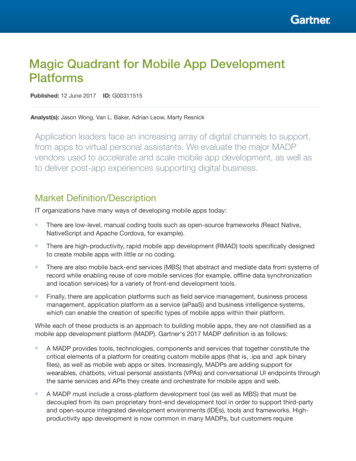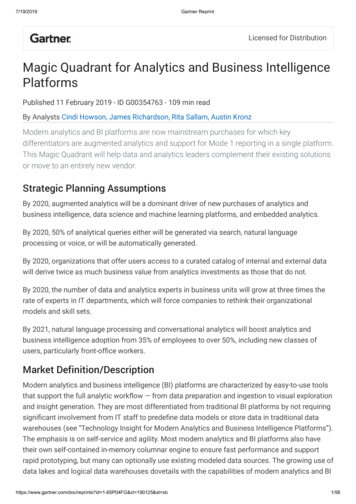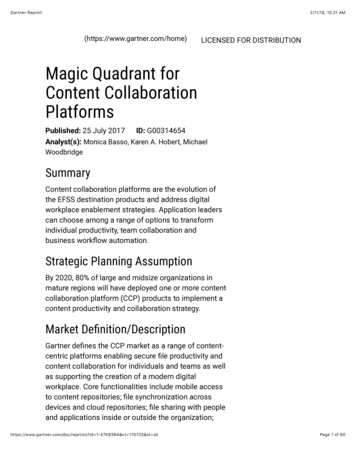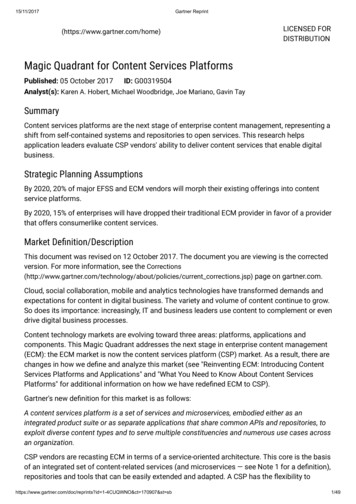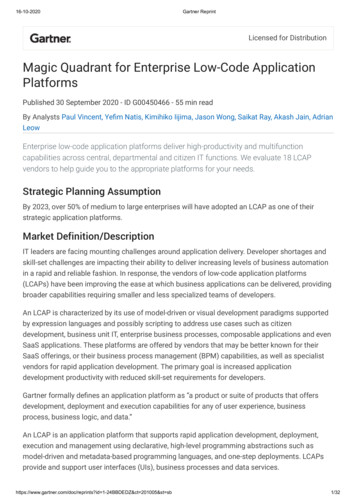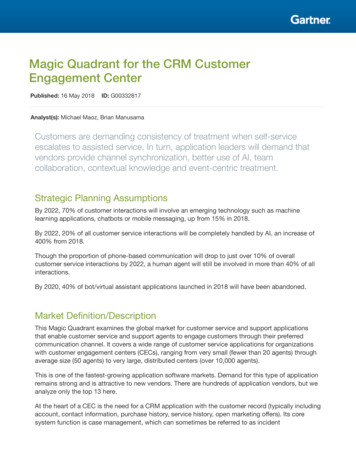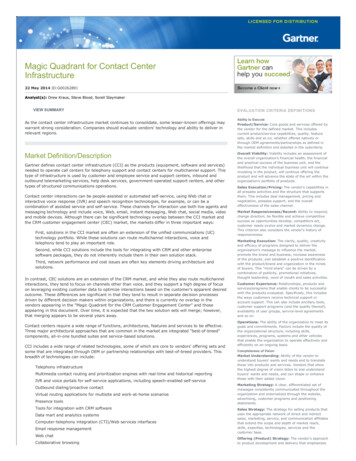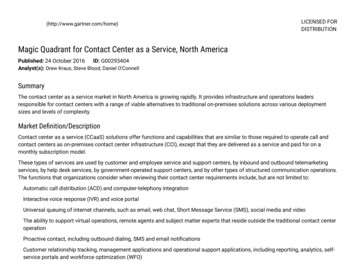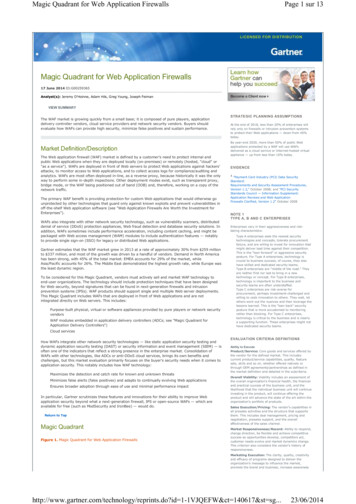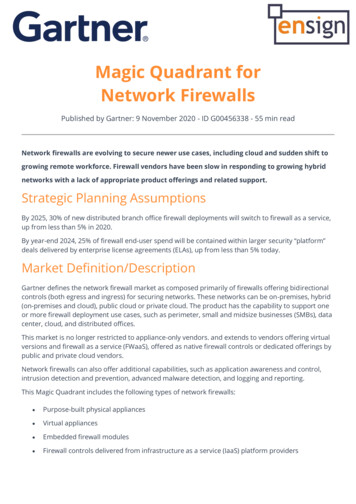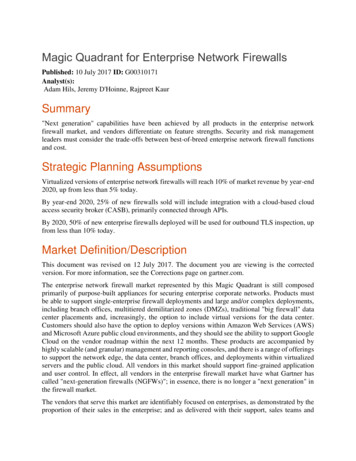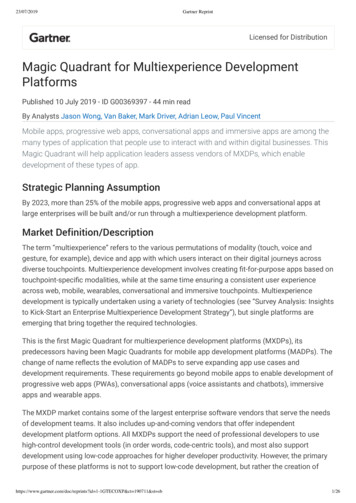
Transcription
23/07/2019Gartner ReprintLicensed for DistributionMagic Quadrant for Multiexperience DevelopmentPlatformsPublished 10 July 2019 - ID G00369397 - 44 min readBy Analysts Jason Wong, Van Baker, Mark Driver, Adrian Leow, Paul VincentMobile apps, progressive web apps, conversational apps and immersive apps are among themany types of application that people use to interact with and within digital businesses. ThisMagic Quadrant will help application leaders assess vendors of MXDPs, which enabledevelopment of these types of app.Strategic Planning AssumptionBy 2023, more than 25% of the mobile apps, progressive web apps and conversational apps atlarge enterprises will be built and/or run through a multiexperience development platform.Market Definition/DescriptionThe term “multiexperience” refers to the various permutations of modality (touch, voice andgesture, for example), device and app with which users interact on their digital journeys acrossdiverse touchpoints. Multiexperience development involves creating fit-for-purpose apps based ontouchpoint-specific modalities, while at the same time ensuring a consistent user experienceacross web, mobile, wearables, conversational and immersive touchpoints. Multiexperiencedevelopment is typically undertaken using a variety of technologies (see “Survey Analysis: Insightsto Kick-Start an Enterprise Multiexperience Development Strategy”), but single platforms areemerging that bring together the required technologies.This is the first Magic Quadrant for multiexperience development platforms (MXDPs), itspredecessors having been Magic Quadrants for mobile app development platforms (MADPs). Thechange of name reflects the evolution of MADPs to serve expanding app use cases anddevelopment requirements. These requirements go beyond mobile apps to enable development ofprogressive web apps (PWAs), conversational apps (voice assistants and chatbots), immersiveapps and wearable apps.The MXDP market contains some of the largest enterprise software vendors that serve the needsof development teams. It also includes up-and-coming vendors that offer independentdevelopment platform options. All MXDPs support the need of professional developers to usehigh-control development tools (in order words, code-centric tools), and most also supportdevelopment using low-code approaches for higher developer productivity. However, the primarypurpose of these platforms is not to support low-code development, but rather the creation ofhttps://www.gartner.com/doc/reprints?id 1-1GTECOXP&ct 190711&st sb1/26
23/07/2019Gartner Reprintmultiple types of app in support of the digital user experience across devices and interactionmodalities.Magic QuadrantFigure 1. Magic Quadrant for Multiexperience Development PlatformsSource: Gartner (July 2019)Vendor Strengths and CautionsNote that all mentions in this section to customer satisfaction scores, survey respondents andreference customers refer to an end-user survey performed as part of our research for this MagicQuadrant (data was collected in March 2019). Vendor-identified reference customers scored variousoverall, functional, product and vendor customer relationship criteria on a scale of 1 to 5 (where 1 extremely dissatisfied, and 5 extremely satisfied). All mentions comparing a vendor’s referencehttps://www.gartner.com/doc/reprints?id 1-1GTECOXP&ct 190711&st sb2/26
23/07/2019Gartner Reprintcustomer feedback to the “average” refer to the calculated average score for each criterion acrossall included vendors (for more details about the survey, see the Evidence section). All reportedcustomer counts are as of July 2019, unless otherwise indicated.AppianAppian is a Visionary. Appian’s platform serves as an MXDP by supporting web, mobile andconversational app capabilities, although it is better-known as an intelligent business processmanagement suite (iBPMS) and low-code application platform. Appian primarily serves themarkets for iBPMSs and low-code application platforms, but is also gaining traction with itsmultiexperience development capabilities.Strengths Viability and innovation: Appian is a mature but growing vendor with deep experience of large-enterprise projects. As a publicly traded corporation, it is managed for growth by aggressivelyreinvesting in platform research and development. This bodes well for the future, given that italso has a strong vision for how to develop multiexperience apps on its platform. Appianreceived one of the highest reference customer survey ratings in this Magic Quadrant for itsroadmap to support multiexperience development needs. Process and workflow orchestration: Appian’s outstanding business rules, process anddecision engine capabilities make it a strong contender for multiexperience development insupport of complex process-oriented use cases that are part of digital business initiatives. Operations: Appian has an impressive and growing set of cloud security certifications, and itinvests in strict security requirements and audits that adhere to a variety of government securityregulations. Additionally, reference customers reported above-average satisfaction with itsservice and support.Cautions Code-centric developer tooling: Appian focuses on a low-code approach to development.Although it provides plug-ins to Eclipse and IntelliJ integrated development environments (IDEs)for extensibility, its model-driven platform is not geared toward professional developers lookingto work in a code-centric environment. Sales execution: Appian has a smaller customer base than other vendors in this MagicQuadrant, since it primarily competes for large projects with complex process automation andmanagement needs. Prospective buyers with more of a focus on front-end app developmentneeds may therefore find Appian’s platform overwhelming. Although Appian has changed itslicensing to accommodate different usage models for different applications, its referencecustomers’ satisfaction scores for contract negotiation flexibility and adaptability were belowaverage. Marketing strategy: Appian’s marketing strategy shows no sign of emphasizing themultiexperience development aspects of its platform. MXDP is just one aspect of the platform,https://www.gartner.com/doc/reprints?id 1-1GTECOXP&ct 190711&st sb3/26
23/07/2019Gartner Reprintone that is jostling for priority in the vendor’s go-to-market messaging and product investments.This may limit Appian’s growth in the MXDP market, even though it has a solid product vision.GeneXusGeneXus is a Niche Player. It distinguishes itself in the MXDP market by offering a flexibledevelopment platform that can generate code for web, mobile, wearable and conversational apps,and PWAs. GeneXus’ platform is centered on the vendor’s proprietary IDE, which enablesdevelopers to write apps in the GeneXus scripting language and then generate native and webcode for multiple app types.Strengths Code-centric developer tooling: GeneXus has its own approach to model-driven development,using its descriptive programming language. The proprietary Windows-based GeneXus IDE is arich development environment for professional developers. GeneXus generates custom code inJava, .NET, .NET Core, Java for Android, Swift, COBOL and RPG, as well as HTML5, JavaScriptand CSS3. This enables developers to build apps in one environment and generate code fordifferent types of app for different touchpoints, as needed. Process and workflow orchestration: GeneXus has a business process management suiteincorporated into its platform that is based on the Business Process Model and Notation(BPMN) 2.0 standard. This gives developers an advantage when building process-centric appsacross touchpoints. The vendor also offers a declarative rules language for defining businessrules that are deployed in apps developed on its platform. Mesh app and service architecture (MASA): GeneXus’ platform offers a service registry featurecalled the Knowledge Matrix, which enables developers to discover, share and publish services.The platform also offers a logging API that works in conjunction with the open-source ElasticStack to facilitate a “big picture” view of services that helps avoid dependency problems. Theplatform has added new stream sources, such as Apache Kafka, Amazon DynamoDB,MongoDB and Elasticsearch.Cautions Operations and sales strategy: Despite efforts to further expand its operations and sales inother regions, particularly the U.S., GeneXus has not gained much traction outside its corecustomer bases in Latin America and Japan. Its reliance on partners outside its core regionshas not yielded the same success as its direct sales efforts in Latin America. Marketing execution and strategy: GeneXus’ strategy of having trial versions, student versionsand user meetings to drive marketing has not yielded significant market expansion orpenetration into global enterprises. The focus on exploiting word of mouth and building itsinstalled base has not been enough to turn the company into a worldwide platform provider. Low-code development: The GeneXus IDE is scripting-heavy and lacks the more visual-centricfeatures that the Leaders in this Magic Quadrant provide. Although the company’s d 1-1GTECOXP&ct 190711&st sb4/26
23/07/2019Gartner Reprintscripting approach offers powerful capabilities, customers looking for graphical-design-orientedtooling may find it less capable than other MXDPs that take low-code approaches, althoughGeneXus has partners that offer integrated visual tooling.IBMIBM is a Niche Player. Its IBM Mobile Foundation offering distinguishes itself in the MXDP marketby providing flexible deployment options, including on-premises, private cloud, public cloud andmanaged service. Additionally, IBM Mobile Foundation is one of the few MXDPs offeringintegrated artificial intelligence (AI) services, which makes it more straightforward for developersto implement chatbots, machine learning (ML) models and other AI capabilities into their apps.IBM Mobile Foundation has an open client architecture model that supports native apps, popularhybrid frameworks and various tool choices for different types of developer, from those workingon augmented reality (AR) to those focused on mobile and web apps.Strengths Core back-end services: Much of the value that IBM’s MXDP offering delivers to customerscomes from its robust and comprehensive back-end services. IBM Mobile Foundation offersstrong support for API adapters used for back-end connectivity in support of MASA. Logic canbe written in adapters to mash up data specific to a channel for consumption. In addition,Gartner observes that its strong core security capabilities are often important differentiators forcustomers choosing the platform. AI services: IBM Mobile Foundation provides out-of-the-box adapters for some IBM Watsoncognitive services, such as Conversation, Discovery and Natural Language Understanding.Other Watson services, such as Speech to Text and Text to Speech, can be accessed usingWatson APIs, and code can be generated using adapters. Geographic strategy and operations: IBM has a significant global presence as it operates inmore than 175 countries. The company’s Sales and Distribution organization managesdedicated country-based operating units, which gives it an advantage over other MXDP vendorsthat don’t have region-based support across the globe. Reference customers’ satisfactionscores for IBM’s ability to meet all expectations set during the sales process, as well as forintegration and deployment, were among the highest received by any vendor in this MagicQuadrant.Cautions Offering strategy: For the past couple of years, IBM has relied on partnerships for front-enddevelopment tooling on its platform, such as with Ionic and Mendix, but this approach entailsseparate product roadmaps and additional purchases by customers. However, in April 2019,IBM released a new low-code tool, the IBM Digital App Builder, which is part of IBM MobileFoundation and as a replacement for the Eclipse IDE plug-in tool. Gartner views IBM’s front-endtooling as a competitive weakness against leading vendors, though IBM Digital App Builderhttps://www.gartner.com/doc/reprints?id 1-1GTECOXP&ct 190711&st sb5/26
23/07/2019Gartner Reprintshould help close the gap. Additionally, reference customers gave below-average satisfactionscores for IBM’s roadmap supporting multiexperience development needs. Monitoring and analytics: Although IBM Mobile Foundation comes with built-in client-sideanalytics for Android, iOS, Apache Cordova, Windows and React Native, surveyed referencecustomers gave the platform below-average scores for monitoring and analytics tools. Moreadvanced analytics capability requires customizations or the addition of IBM Watson CustomerExperience Analytics Mobile, but reference customers said they needed more out-of-the-boxfunctionality for effective real-time tracking and analytics. Process and workflow orchestration: IBM Mobile Foundation received below-averagesatisfaction ratings from reference customers for its native process and workflow capability.Supporting such orchestration requires separate IBM products, notably IBM Digital BusinessAutomation and IBM Cloud Functions. Customers can use the IBM business processmanagement (BPM) adapter for IBM Mobile Foundation, which provides access to IBM’s BPMREST APIs.KonyKony is a Leader. Its rebranded Kony Quantum platform distinguishes itself in the MXDP marketwith a strong track record for mobile app development, but it can also support smartwatch, ARand conversational apps, and PWAs.Strengths Offering strategy: Kony enables the delivery of high-end user experiences across multipletouchpoints. Its platform combines a low-code approach for developers with MASA bestpractices, through the use of API management and comprehensive back-end services. Industry strategy: Kony has strong presence in a number of industries, and partnerships withco
This is the first Magic Quadrant for multiexperience de velopment platforms (M XDPs), its predecessors ha ving been Magic Quadrants for mobile app de velopment platforms (M ADPs). The change of name reflects the e volution of M ADPs to ser ve expanding app use cases and development requirements. These r equirements go be yond mobile apps to enable de velopment of
